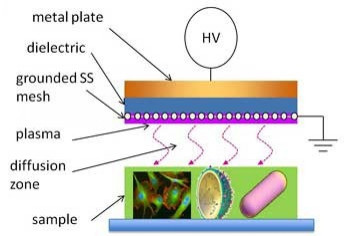Ionized Plasma Tapped as Cheap Water Sterilizer for Third World

Can ionized plasma, likes the one in neon lights and plasma televisions, sterilize water?
Scientists at the University of Berkeley, California, have now shown that devices capable of producing such ionized plasmas can not only sterilize water but also make it antimicrobial, by killing bacteria. In addition, the antimicrobial effect can be sustained for as long as a week.
The impact of the study could result in cheaper solutions to sterilize and disinfect water in developing countries, disaster-stricken areas and even in armed conflict zones. Furthermore, the application could find use in treating water for medical causes in third-world economies, where sterilized water is either in short supply or very expensive to produce. The results of the study could, therefore, be a godsend in poor countries or those where access to non-contaminated water is difficult.
The researchers will now working on developing a host of techniques that could allow individuals and local communities to handle their own water supply, by disinfecting it on their own; this should allow them access to clean and fresh water on a regular basis.
We know plasmas will kill bacteria in water, but there are so many other possible applications, such as sterilizing medical instruments or enhancing wound healing, said chemical engineer David Graves, the Lam Research Distinguished Professor in Semiconductor Processing at UC Berkeley, We could come up with a device to use in the home or in remote areas to replace bleach or surgical antibiotics.
Low-temperature plasmas as disinfectants are an extraordinary innovation with tremendous potential to improve health treatments in developing and disaster-stricken regions, said Phillip Denny, Chief Administrative Officer of UC Berkeley's Blum Center for Developing Economies, which helped fund Graves' research and seeks to address the needs of the poor worldwide.
One of the most difficult problems associated with medical facilities in low-resource countries is infection control, added Graves, It is estimated that infections in these countries are a factor of three-to-five times more widespread than in the developed world.
The study published in the November issue of the Journal of Physics D: Applied Physics reported that water treated with plasma killed essentially all E. coli bacteria, within a few hours of treatment and continued to kill 99.9 percent of bacteria after standing for as long as a week. Mutant strains of E. coli have been known to contaminate meat, cheese and vegetables, causing outbreaks of intestinal diseases and could even be.
Based on other experiments, Graves and his colleagues at the University of Maryland in College Park, earlier reported that plasma could also kill dangerous proteins and lipids, including prions or infectious agents that cause mad cow disease. These prions cannot be detected through standard sterilization processes.
The team showed that plasmas generated by brief sparks in the air, while next to a container of water, made the water as acidic as vinegar and created a cocktail of highly reactive and ionized molecules. The latter are molecules that have lost one or more electrons and are ready to react with other molecules. The researchers identified the reactive molecules as hydrogen peroxide and various nitrates and nitrites; which are categorized as antimicrobials.
Initially, Graves said he was puzzled by the fact the water remained antimicrobial, even after a week and even when the peroxide and nitrite concentrations had dropped to zero. This indicated the presence of another reactive chemical, one he suspected as nitrate, in the water.
I'm a chemical engineer who applies physics and chemistry to understanding plasmas, said Graves, It's exciting to now look for ways to apply plasmas in medicine.
Plasma devices have been used as surgical instruments to remove tissue or coagulate blood. However, the use of low-temperature plasmas as disinfectants is a recent breakthrough for direct medical therapy, explained Graves, who has recently begun focusing on the medical applications of plasmas after having worked for more than 20 years on the kind of low-temperature plasmas used to etch semiconductors.
© Copyright IBTimes 2024. All rights reserved.





















